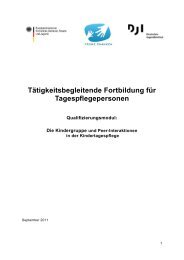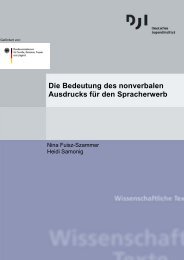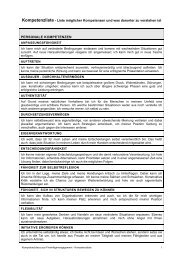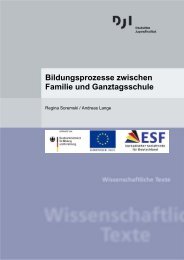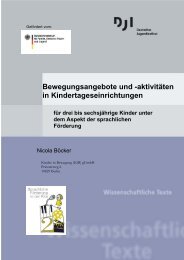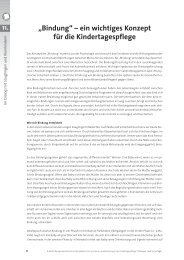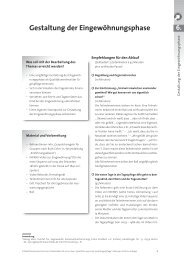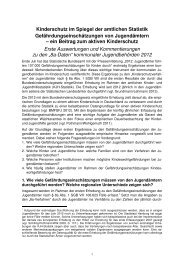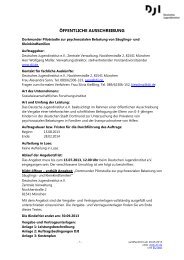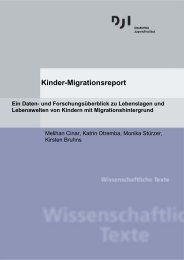download - Deutsches Jugendinstitut e.V.
download - Deutsches Jugendinstitut e.V.
download - Deutsches Jugendinstitut e.V.
Create successful ePaper yourself
Turn your PDF publications into a flip-book with our unique Google optimized e-Paper software.
Example of local implementation – Nuremberg<br />
The city of Nuremberg (large city in the Bavarian region of Franconia with ca. 500,000<br />
inhabitants) fulfils the requirements for the implementation of the E&C programme<br />
platform: 15 % of children and young people leave school without qualifications, 10 % of<br />
the population are dependent on social security payments according to the SGB II<br />
[German Social Security Code] and approximately a third of adults and ca. 40 % of children<br />
and young persons have a migrational background. As in all larger German cities, social<br />
problem complexes are concentrated on so-called social focal points or disadvantaged<br />
neighbourhoods.<br />
The experiences described in Nuremberg in the three social city areas Nordostbahnhof,<br />
Altstadt-Süd and Galgenhof/Steinbühl focus primarily on the programme LOS – Local<br />
Capital for Social Purposes (cf. also AG5). Other programme elements were unfortunately<br />
not able to achieve the intended results, although follow-up project efforts can naturally<br />
learn from these experiences. The forerunner of the LOS project – “Competence and<br />
Qualification (KuQ) – suffered from its over-short duration, whereas in the “Voluntary<br />
Social Training Year (FSTJ), the potential of new cooperation forms were not recognised<br />
by all participants.<br />
In Nuremberg, the LOS principally supports small, local and frequently unconventional<br />
project concepts and initiatives – so-called micro-projects – which cannot be incorporated<br />
into larger-scale support programmes. The aim is to create structures and networks<br />
through these micro-projects which will continue to exist beyond the duration of the<br />
support programme and which will improve living and working conditions of the<br />
population in the relevant city areas. Micro-projects can be offered by initiatives,<br />
associations, educational and organisational institutions, welfare and economic associations,<br />
church communities, local businesses or also by individual persons or start-up<br />
entrepreneurs with good ideas.<br />
The core of the implementation structure is the coordination office in the Youth<br />
Welfare Office in Nuremberg. Cooperation with the area management in the supported<br />
city areas is continuous and effective. An accompanying committee (BGA) was specifically<br />
created to decide on the allocation of project funds in the city areas. The work of this<br />
committee guarantees that all social actors (supporting bodies and local economy), but<br />
above all young people and the inhabitants of these disadvantaged areas, can be involved in<br />
the relevant decisions affecting them: for many of these people a new experience.<br />
The socio-environmental organisation structure of the overall programme<br />
implementation also harbours innovative potential. People have always been indifferent as<br />
to which specific organisation or administrative department has offered their services. The<br />
same does not however apply to the institutions involved. Even the “Socially Integrative<br />
City” programme or the E&C is not a universal remedy for departmental vanities and<br />
egoism, and the development of integrated overall strategies is certainly not made easier<br />
when administrative departments in local authorities assign areas of responsibility to<br />
associations with differing political colours. It can however be established that concrete<br />
collaboration between authorities and bodies, the common desire to discover solutions and<br />
54



